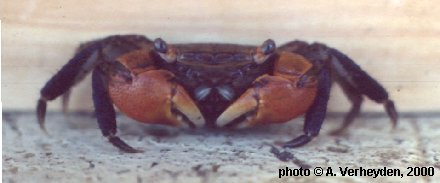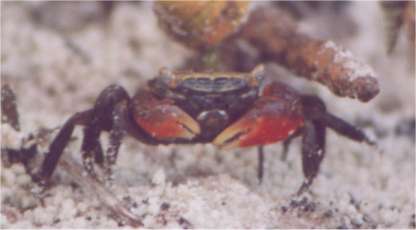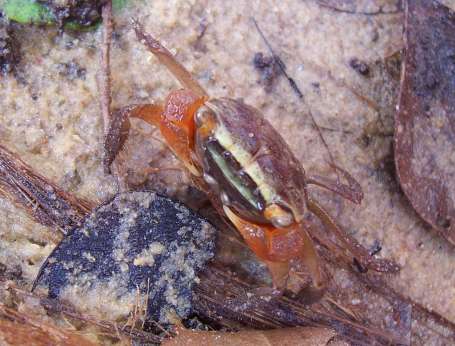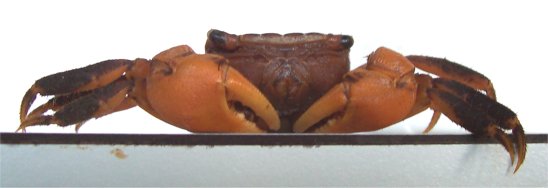|
A field guide to Kenyan
mangroves
|
Chiromantes ortmanni (Crosnier, 1965)
Family: Sesarmidae

|
Zone: A. marina landward zone to terrestrial. Habitat: Utilizes burrows of others (Gillikin, 2004) and can construct their own burrows (Gillikin & Kamanu, 2005). Food: Omnivorous, but stomach content studies show them to eat mostly leaves (Dahdouh-Guebas et al., 1999). Ecological notes: Very common in A. marina landward zone (Ruwa, 19997; Gillikin, 2000). Often found in N. meinerti and C. carnifex burrows (Gillikin, 2000). Tolerates high salinities, probably as a trade-off for reduced competition and predation (Gillikin, 2004). C. ortmanni have well developed setae between the walking legs, which can probably efficiently extract pore water (Hartnoll, 1988; Ng and Liu, 1999). |
|
Distinguishing characteristics: Carapace brownish yellow, but highly variable (two specimens can look very different). Tubercles on upper margin of claw mobile finger uniform, feels relatively smooth when a finger nail is scraped across it [see the comparison images with C. eulimene] (carapace width about 1.5 cm). Note that Chiromantes ortmanni is often referred to as Sesarma ortmanni in the literature.

Chiromantes ortmanni (left) and Chiromantes
eulimene (right)
(more comparisons here)
Geographical range: Somalia, Kenya, Tanzania, Madagascar (Hartnoll, R.G., 1975; Vannini and Valmori, 1981)


References:
Cannicci, S., F. Dahdouh-Guebas and L. Montemagno, 1993. "Field Keys for Kenyan Mangrove Crabs." Museo Zoologico "La Specola", Dipartimento di Biologia Animale e Genetica dell'Università Degli Studi di Firenze, Via Romana 17, I-50125 Firenze, Italia.
Gillikin, D.P. and C.P. Kamanu, 2005. Burrowing in the East African mangrove crab Chiromantes ortmanni (Crosnier, 1965). Crustaceana.78: 1273-1275 (reprint)
Gillikin, D.P., 2004. Osmoregulatory ability of Chiromantes ortmanni (Crosnier, 1965) subjected to dilute and hypersaline seawater. Crustaceana 77(1): 67-74.(REPRINT)
Gillikin, D.P., 2000. Factors controlling the distribution of Kenyan brachyuran mangrove crabs: Salinity tolerance and ecophysiology of two Kenyan Neosarmatium species. M.Sc. Thesis, Free University of Brussels, Brussels, Belgium.
Hartnoll, R.G., 1975. "The Grapsidae and Ocypodidae (Decapoda: Brachyura) of Tanzania." J. Zool. Lond. 177:305-328.
Hartnoll, R.G., 1988. Evolution, systematics, and geographical distribution. In: W.W. Burggren & B.R. McMahon (eds.), Biology of the Land Crabs: 6-54 (Cambridge University Press, Cambridge, U.K.).
Ng, P.K.L., and H.C. Liu, 1999. The Taxonomy of Sesarma tangi Rathbun, 1931 and S. stormi De Man, 1895 (Crustacea: Decapoda: Brachyura: Grapsidae: Sesarminae), with Establishment of a New Genus for S. stormi. Zoological Studies 38(2): 228-237.
Ruwa, R.K., 1997. "Zonation of burrowing crabs in the mangroves of the East Coast of Kenya." In Kjerfve, Björn, Luiz Drude de Lacerdaand El Hadji Salif Diop (eds.). Mangrove ecosystem studies in Latin America and Africa. UNESCO Technical Papers in Marine Science, Paris, France. Pp. 316-324.
Vannini, M. and P. Valmori, 1981. Researchers on the coast of Somalia. The shore and the dune of Sar Uanle. 30. Grapsidae (Decapoda Brachyura). Monitore Zoologico Italiano 6: 57-101.
